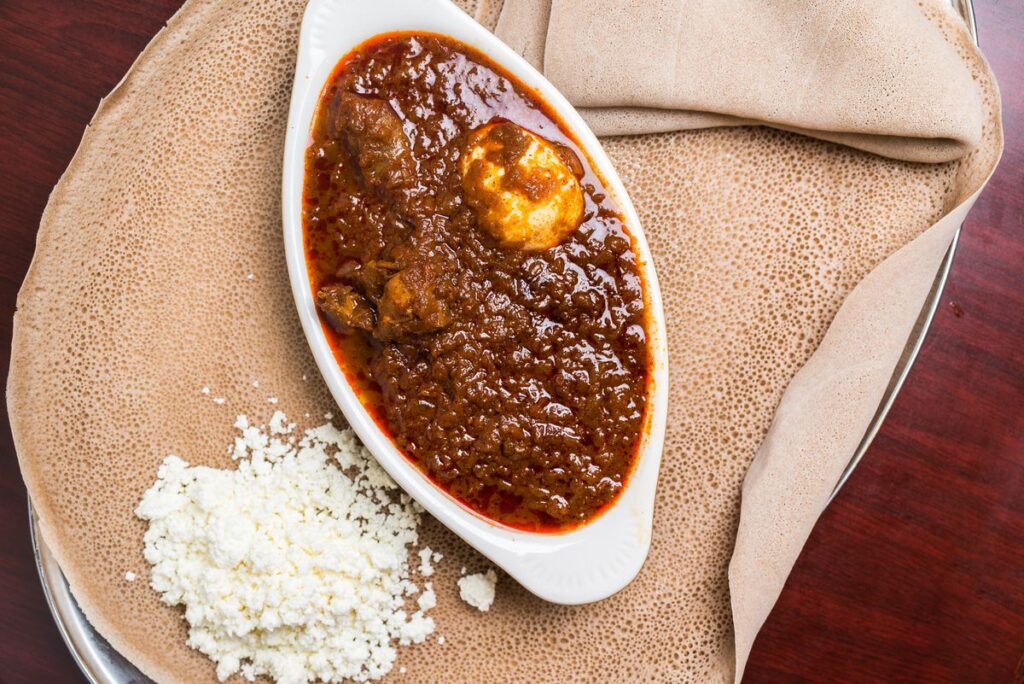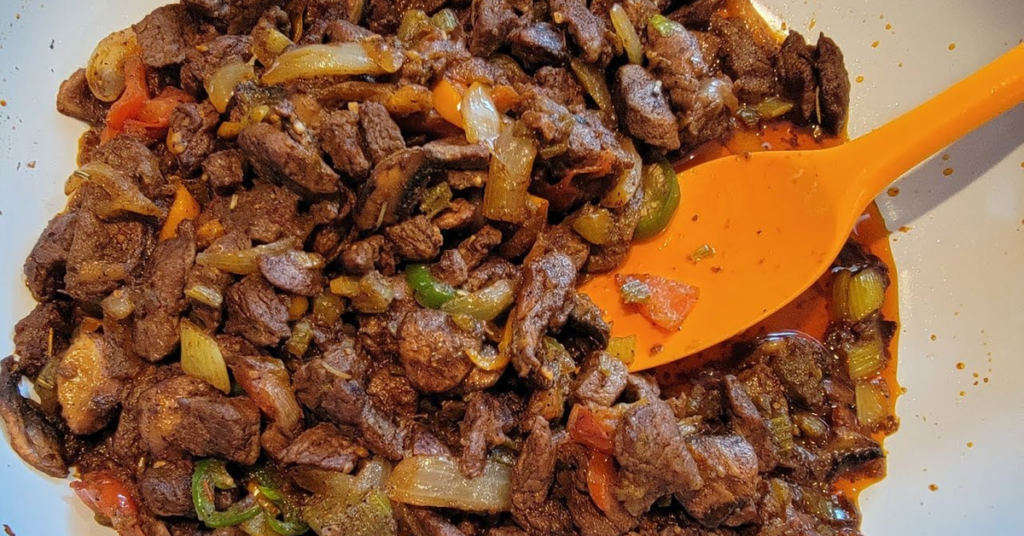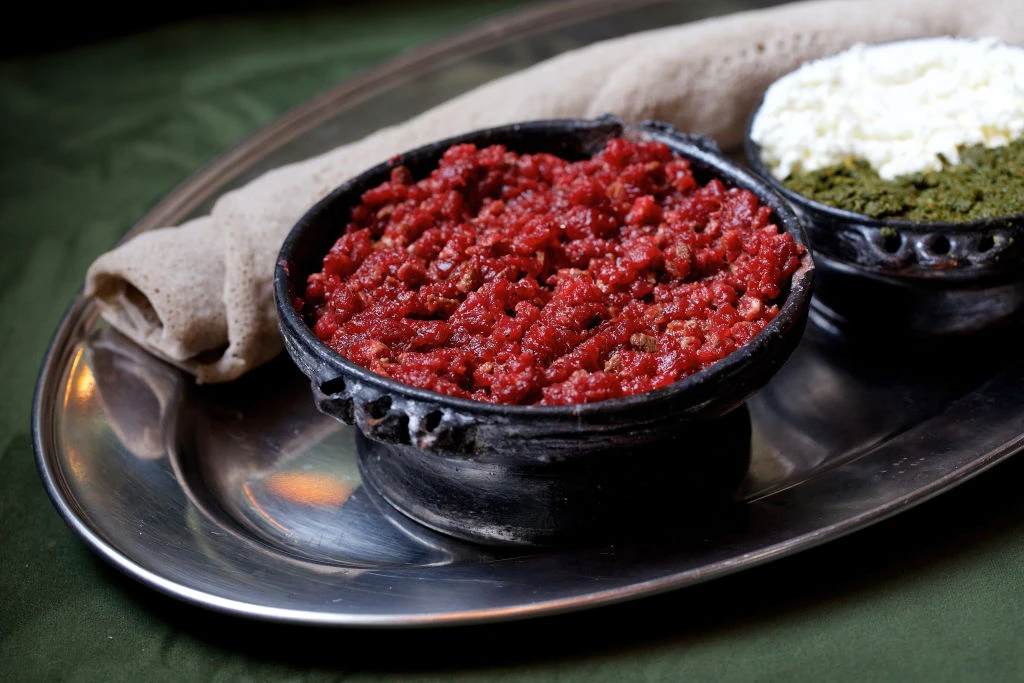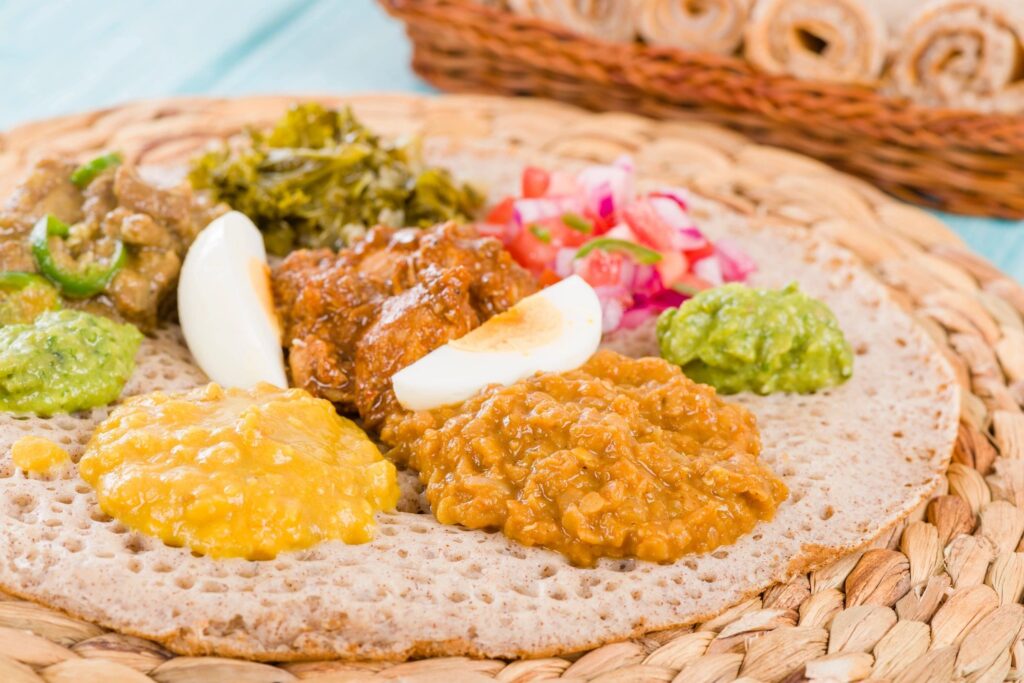Ethiopian cuisine is excellent and unusual, befitting a country with a unique cultural background. There is no exaggeration in saying that the traditional foods of Ethiopia is still one of the world’s best-kept secrets. Many of our preconceptions about dinnertime are challenged when we eat Ethiopian-style. For most of us, this means forgoing utensils and preparing to get our hands a little messy. That’s because injera, a pancake-like bread, is the core of most Ethiopian meals, serving as a base for a wide diversity of dishes, from rainbow stews to vegetable curries to cubes of raw meat.
The traditional foods of Ethiopia vary by region, and there are some traditional dishes that Ethiopians eat during holidays. The conventional food varies on what the main activity is for a particular holiday.
What is Wot? Ethiopia’s take on the curry dish

Using strips of injera cut off the sides of a huge circular metal tray of injera, everyone gathers around the tray to scoop up food from the many heaps arranged around it. It can take you a while to get accustomed to all of this. Injera has been mistaken for tablecloths and kitchen linens by visitors. Because of its sour-bitter taste, some people find the bread unappetizing. However, injera’s subtle flavor-enhancing strength resides in how it complements and tempers the spicy sauces it accompanies with ease.
The use of spices is not something Ethiopians or Indians hold back on. It’s customary to have berbere, an Ethiopian spice blend that includes 16 different ingredients such as chile powder and fenugreek and garlic, and cardamom. Tef, which is the world’s tiniest grain, has been prized and farmed for millennia by Ethiopians, and injera is manufactured from this grain. For many US and European inhabitants, it has been dubbed a “super grain” because of its high levels of protein and calcium and its gluten absence. As a consequence, your taste buds will be writhing in delight, and your health will benefit from this.
Foods that are packed with nutrition and low in fat make up the bulk of most Ethiopian cuisine. Ethiopian coffee is a must-try after a meal, even if you eat anything from the extensive menu. Many people consider Ethiopian coffees to be the greatest globally since they originate high-quality Arabica coffee. We’ve rounded up 15 must-haves:
Tibs-Traditional Foods of Ethiopia

Tender chunks of beef are served in a clay pot. Tibs is one of Ethiopia’s most popular meals, consisting of sliced beef or lamb pan-fried with butter, garlic, and onion. It is available in several styles, ranging from mild to spicy, and includes a wide range of meats and vegetables. Shekla tibs, in which the beef strips are roasted in a clay pot fueled with hot coals, are a highly recommended variety. Traditionally, tibs got offered as a way to demonstrate gratitude or respect. It’s still considered a special meal, which is why it’s so famous for honoring festivals and special occasions.
As a side note, if you stroll into an Addis Ababa pub on a Friday afternoon and order tibs, you’re likely to see a large number of revelers doing the same. Meat from hanging carcasses is usually used to make the tibs you’ll see on your plate at most restaurants. Meat seldom tastes better or fresher than it does at the grocery store.
Kitfo

Ordinary Ethiopians regard kitfo as a particular pleasure, and they appreciate its nutritional benefits as well. For this dish, minced beef is heated in a skillet with butter, mitmita (the most potent form of Berbere), and occasionally thyme. The traditional way to eat kitfo is leb leb (warmed, not cooked), although you can request betam leb leb if you want (“very warmed,” which means cooked). When served with aib (similar to dry cottage cheese) and gomen (minced spinach), kitfo becomes even more full and satisfying, making it an ideal meal to recover from a long day of traveling or a late night of drinking.
Beyainatu-Traditional Foods of Ethiopia
At the same time, Beyainatu allows you to enjoy a wide range of flavors. Injera, Ethiopia’s most popular vegetarian food, refers to “a bit of everything,” thus, your injera arrives smothered in a rainbow of veggies, potatoes, curries, lentil stews, and more. If you’re looking for something to eat while fasting from meat, beyainatu is an excellent option. You’ll find it in restaurants of all kinds, from high-end hotels to roadside vendors, all around Ethiopia. As a result, beyainatu is a safe and straightforward option while traveling or presenting a menu exclusively in Amharic. Whether or whether they are vegetarian, beyainatu is a favorite dish for many travelers visiting Ethiopia.
Fuul
A popular breakfast dish in Ethiopia, Ethiopian fuul is made of fava beans cooked and seasoned with various herbs and spices. This type of fuul is often served as a little piece for one person, but it’s accompanied by an inexhaustible supply of freshly baked bread. The so-called “special” fuul is ordinarily large enough to feed two people and is topped with yogurt, tomato, green chile, onion, egg, and occasionally avocado. Locals combine this mixture with salt, other spices, and fresh chiles and season to taste.
In a proper fuul-serving diner, your food will get served in little metal bowls that are too hot to handle, with diners holding on to the bowl’s side with a torn-off piece of bread. In the Ethiopian capital, Addis Ababa, fuul is a nutritious, quick lunch that one can have in less than ten minutes before a client heads out into the bustling metropolis to begin their day’s job.
Tere siga-Traditional Foods of Ethiopia
Ethiopian specialties include chunks of raw red flesh that aren’t for the squeamish. If you’re eating with two people, you’ll usually have the half-kilo option for each, which is served with bread to hold the uncooked meat together and a generous quantity of mitmita to dunk it in. As a military stratagem in the 16th century, Ethiopians acquired a taste for raw meat to evade notice by not having to make fires to prepare their meat. While most Ethiopians claim that eating tere siga makes them feel like they’re on top of the world, eating raw beef can pose a health hazard to some degree. Although this author hasn’t had any post-tere siga difficulties, this spans from tapeworm to salmonella (though if one is concerned after a trip to Ethiopia, a simple tablet available from pharmacies can get taken to neutralize any tapeworm risk).
Doro wot
Ethiopia’s form of curry is a constant companion of injera and is a staple of Ethiopian cuisine. Despite the prevalence of beef and goat in wot recipes, the Amharic word for chicken, doro, takes the cake. Chicken drumsticks or wings are cooked in a fiery sauce of butter, onion, chili, cardamom, and berbere before being served with the sauce. A hard-boiled egg floats in the middle of this soup. As a token of respect, it’s usually given to a visitor to accompany their meal. Doro wot Ethiopians’ go-to dish during national and religious celebrations (the day before, women can be seen everywhere carrying upside-down clucking chickens by their feet).
Enkulal firfir-Traditional Foods of Ethiopia
It may seem like scrambled eggs, but Ethiopia’s enkulal firfir should be on your morning menu. Nitre kibe, an Ethiopian spicy butter, is used to cook the dish, then topped with a mixture of green and red peppers, chili, tomatoes, and onions. Enkulal firfir has a wonderfully golden yolk, which results in a considerably superior flavor compared to the pale egg yolks produced in the west. Enkulal tibs is the name given to the omelet variation. Scrambled eggs will never taste the same once you try enkulal firfir, so get prepared.
Dulet
It may be more appealing to the inexperienced if this meal of mixed meats is not translated and explained. An animal’s stomach is minced together with liver and lean beef with butter, onions and chili, cardamom, and pepper to create this dish delicately on the Indian subcontinent.
Tegabino shiro-Traditional Ethiopian Foof
Shiro, a chickpea or bean purée, is a favorite among Ethiopians on fasting days because of its somewhat spicy flavor. Sloppy sludge is one of the most understated foods you’ll discover. It’s delicious. According to the location, Shiro is frequently spiced up with additional ingredients such as minced onions, garlic, or/and ground ginger. It is a form of shiro prepared with legumes like chickpeas, field peas, or fava beans that are strongly spiced with flour and oil or butter and cooked to a boil before being served in a tiny clay pot.
Ti’hilo
Barley balls punctured by carved sticks with two prongs at the end and dipped in a fiery-looking sauce prepared from pulses, flour, and spices are Ti’hilo, Ethiopia’s equivalent to Swiss fondue. This meal, like many in Ethiopia, is served with a degree of ritual: An Ethiopian waiter or waitress arrives and sits at your table, scooping and rolling little balls of barley between their hands before placing them on the dish of injera for you to bite into, dip, and enjoy. In the past, ti’hilo was only found in a tiny area of Tigray, surrounding the city of Adigrat. Still, today it’s gaining on and spreading throughout Ethiopia because of its delicious and healthy qualities. Ti’hilo may be found in Addis Ababa if you can’t make it to Tigray, although you may have to inquire around.
Dabbo fifir
An example of Ethiopian cooking’s capacity to take something basic and make it more complex is dabbo firfir, a dish made by mixing bread pieces with clarified butter and berbere, frequently accompanied with yogurt. Dabbo firfir, like shiro, is unexpectedly delicious despite its tiny appearance. In addition, Ethiopians are prepared to use a spoon or fork in this case.
Fatira-Traditional Foods of Ethiopia
For a traditional breakfast meal in the Horn of Africa, Fatira often has thin pastry on top and bottom, with eggs and honey in the center. It’s usually served in a huge serving, although it may easily feed two people. Ethiopia’s eastern city of Harar is known for its street food version of Fatira, which consists of tiny square portions fried in the open on a large frying pan in the middle of the street. There are few better methods than with a cup of Ethiopian coffee to begin a day of Ethiopian exploration.
Asa-Traditional Foods of Ethiopia
Eating fish in Ethiopia is an unforgettable experience. To make it appear like you’ve got a Piranha on your plate, fish like Nile perch is often deep-fried and presented whole. Either injera or bread is used to scoop up the spicy sauce, always consumed by drizzling it over your fingers. Ethiopians eat everything to save a few bones, and they’re right to do so; the grilled fins are incredibly delicious. Succulent fish slices cooked with sesame oil, garlic, and ginger with berbere spice are known as asa tibs in Ethiopian cuisine. If you don’t wish to deal with the effort of picking out bones or contemplating the fish’s angry-looking face, this is an intelligent choice.
Spriss
Addis Ababa has plenty of juice houses, many of which are just shacks, serving up sprissy, tasty juice combinations made from avocado, mango, papaya, pineapple, and orange. Spriss is made by layering juices from three different fruits on top of one other and mixing them. The pureed juice is topped with a lime squeezed over the top, and there is no water, sugar, or ice in it. If you’re an Ethiopian, you may want to squirt in a purple cordial that the author hasn’t yet figured out. Triangular slices of sweetened bread are commonly given with a juice, which serves as a satisfying snack, especially if you decide for your glass to be filled with avocado puree. Sweet and refreshing, Spriss is a welcome reprieve from the spiciness of the rest of the meal.
The traditional food of Ethiopia is a huge part of traditional culture and heritage. Still, like traditional foods in many other countries, it has been irreversibly changed by outside influences such as colonialism. Traditional food can still get found in the country, but it’s often hard to locate and difficult to understand because of cultural differences.
Recommended Reads
- Popular Dishes in India-Top 15
- Traditional Foods of Colombia-Top 20
- Traditional Food From Chile-Top 12 Delicious Dishes You Must Try
- Foods from Amsterdam-15 Must-Try
- Top 12 Things for Which Turkey is Famous


